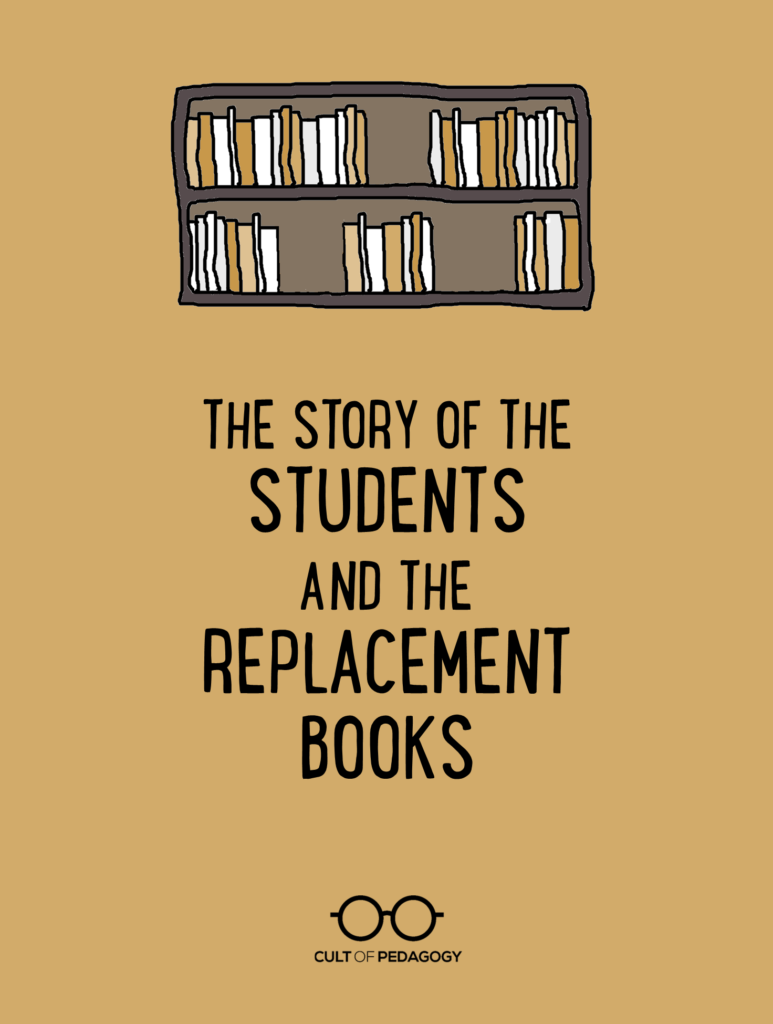
On some days, teaching can crush our souls. But on other days it does the opposite. This story is about both kinds of days.
Hannah Thompson is a high school English teacher at Monrovia High School in Monrovia, Indiana. She’s brand-new to the profession this year.
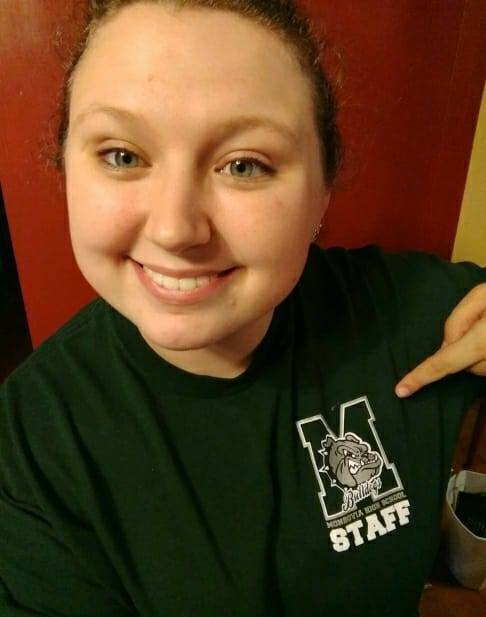
Hannah Thompson
Like most other English teachers, Thompson had a classroom library. This being her first year, the library was still on the small side, but it had been built with love.
“I’ve wanted to be a teacher for a very long time,” she says. “I was still in high school when I got the first book strictly for my future classroom.”
Thompson stocked the library with books she’d loved when she was a student—many were her own original copies. As she introduced various books in the library to students, she told some of the stories behind them: The book that had gotten her into trouble for reading it when she was supposed to be doing her math homework. The other one that kept her up all night in middle school.
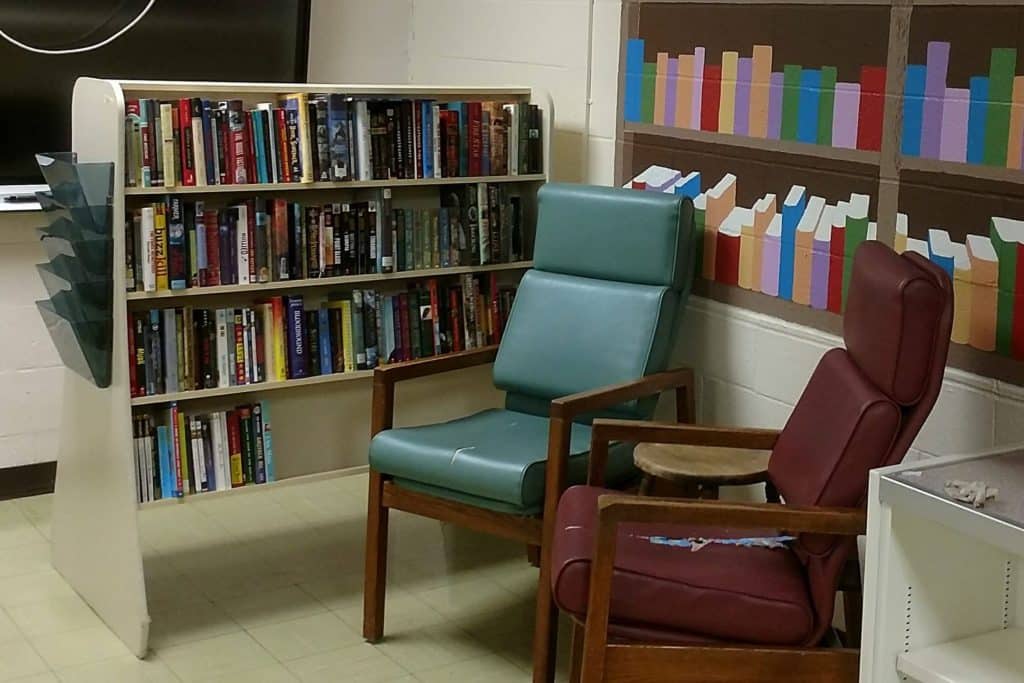
“More than anything,” Thompson says, “I wanted to share the books I loved or the books that they could love.”
Alongside her own beloved fantasy and adventure books, Thompson added other genres, paid for with her own money. “Sports books, military books, dog books, books about high school drama, murder mysteries, puzzle books, graphic novels, history, and even some Nicholas Sparks. No matter who they were, students should be able to find something they would enjoy back there.”
Students were given five minutes at the start of every class period to read independently, and they were encouraged to use books from the classroom library. Thompson’s only request was that they check the books out if they wanted to take them out of the room.
A Rough Start
Ask any teacher about his or her first year, and you’ll hear stories about all the stuff that went wrong. Hannah Thompson’s challenges came mostly from her sophomores.
“I teach four classes of sophomores and two classes of juniors,” she explains. “The sophomores as a whole have delighted in hazing the new teacher. Among other things, I have a running list of my possessions that have been broken in sophomore classes: My fan has been broken twice, we are on our sixth stapler in three months, cacti that my friend had crocheted for me—whose pots I’d painted over the summer to use as numbered stations for things—were swept off my desk and shattered.”
The damage has extended to books: “My wax warmer was dumped all over my books, and the class set of The Strange Case of Dr. Jekyll and Mr. Hyde was banged up after only three days of use, and some were destroyed: Four were taken out of the room and not returned, one was ripped in half, and one had a BITE taken out of it.”
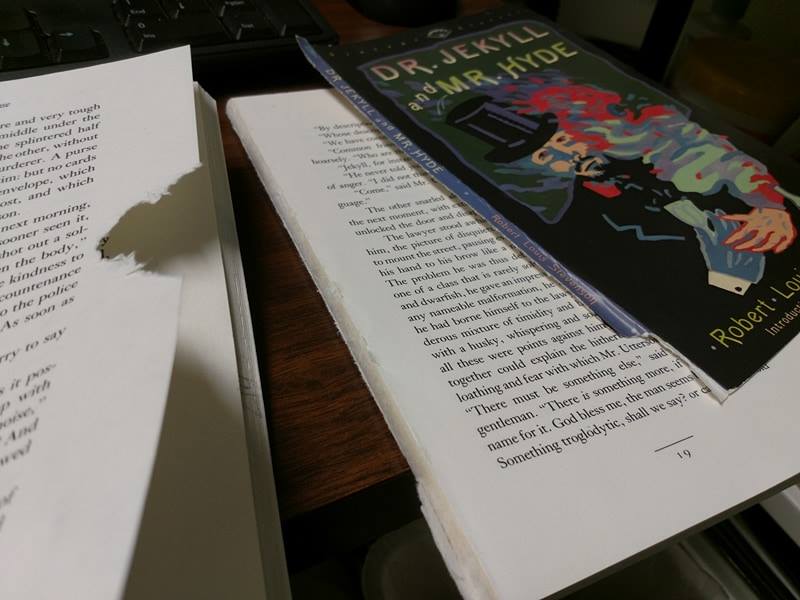
Thompson is quick to point out that this behavior does not represent all of her 10th-grade students. “I have some truly wonderful sophomores,” she says. “But the behavior of some has overshadowed the rest.”
Hearing about the trouble she was having with the younger students, Thompson’s juniors sometimes tried to compensate. “I’ve been surprised many times by juniors who’ve heard I’d had a rough day,” Thompson says. “Once, one student divided up a huge bag of M&Ms and left some on my desk, a few wrote me kind notes (which are now taped on my mini fridge), and one gave me a stuffed Charmander.”
Despite these experiences, nothing could have prepared Thompson for what happened right around Thanksgiving, when she noticed books were disappearing from her classroom library.
The Missing Books
“It took me longer than it should have to notice books disappearing,” Thompson admits. “I noticed that the shelves never looked full, but I didn’t realize how many were missing.”
Books were rarely returned to the library in an orderly way: They were often put back on their sides or with the spines turned inward. They were regularly left under desks. Some favorites were hidden in the room by students who wanted to prevent others from checking them out.
One day in mid-November, in preparation for parent-teacher conferences, Thompson and a few students rounded up the books that had been scattered around her classroom.
“Once every book they found was on the shelf and the shelves were straightened up,” she says, “I noticed that about a shelf and a half were missing.”
She decided she would eventually need to move the books to another location to keep a closer eye on them, but decided to wait until Thanksgiving break.
As she was leaving her room for the day, she happened to look down while turning off the lights. “I saw one of my books in the trash can,” she says. “When I pulled it out, I saw another. Three of them were in there that day.”
The books weren’t just getting lost or misplaced. Students weren’t just checking them out and forgetting them.
The truth behind the missing books hit her: They weren’t just getting lost or misplaced. Students weren’t just checking them out and forgetting them; in fact, according to Thompson’s records, only a handful of books were officially checked out.
The following week, Thompson moved her books into a new cabinet. When students asked about the empty bookshelf, she explained why the books had been moved. This was when another student admitted to seeing five other books in the recycling bin the week before.
“With eight books confirmed to have been thrown away in a week,” Thompson says, “who knows how many more of the missing ones were just thrown in the trash?”
Once the final count had been completed, she estimates that of the nearly 200 books in her original library, over 60 books had gone missing. And as far as she could tell, a whole lot of them were being trashed by her own students.
“I just couldn’t believe that they would go so far as to just throw them in the trash. What makes someone decide to do that? Were they lashing out at me? Did they just hate the books? Did they just not want to carry them back to the shelf? Why?”
And Sometimes They Surprise You
Then on the last day of November, Thompson was in her classroom and looked up to find four of her juniors walking in with armloads of books: 70 of them to be exact.
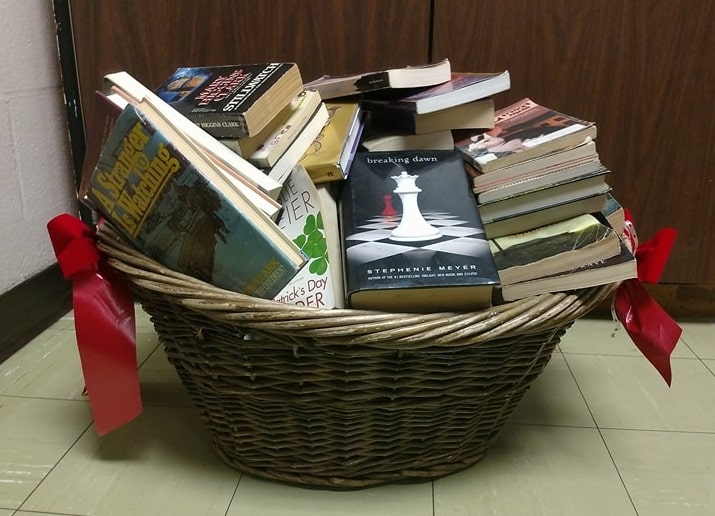
As soon as she saw the students walking in, Thompson knew what was going on. “I bawled,” she says. “Immediately. I saw them walking in and my eyes got watery.”
They handed her this note:
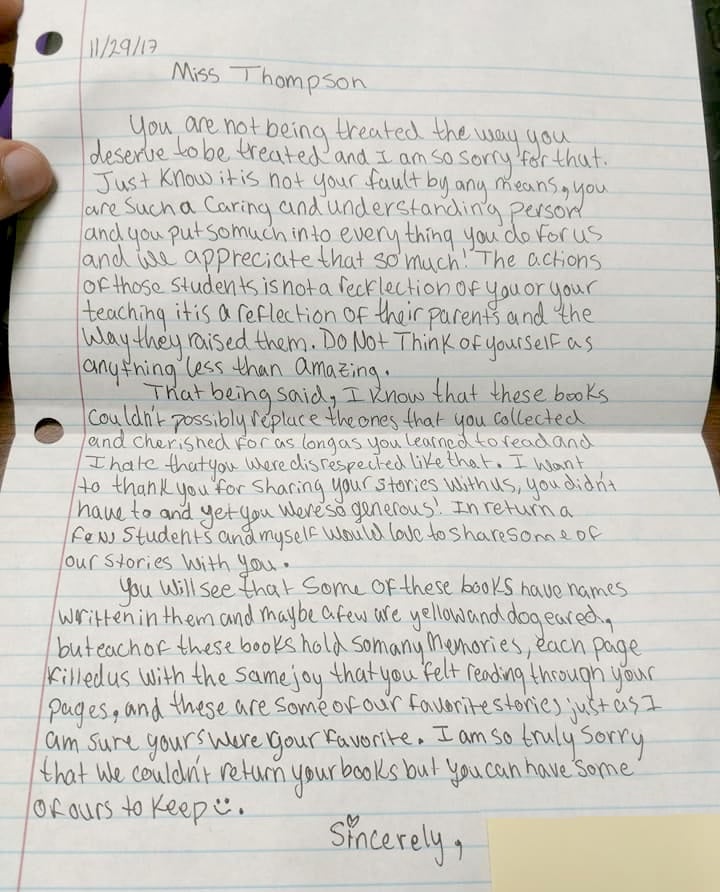
Some of the books had come from the students’ own collections, and others they had just bought.
“No one has ever done anything so nice for me before,” Thompson says. “I couldn’t stop smiling all day. I even joked with some of my rough students.”
She shared the story with as many people as she could. “I told everyone I saw,” she says. “I sent a picture of the letter to my fiancé during lunch and told him what they’d done. He told me to tell them all that he loved them. I called my mom as soon as the bell rang and heard her choking up on the other end. I emailed all of their parents and told them how grateful I was and how much I appreciated them. I also apologized for the unprofessionalism of hugging their kids.”
At a time when it would be easy to focus only on the negative stories we hear about students, it’s important to stop and pay attention when something good happens. And despite how deeply hurt she was by the trashed books, Thompson has never stopped seeing the positive in all of her students.
“There are absolutely stellar individuals among them,” she says. “I see the amazing people they are every day in class. How kind some of them are. Funny in a way that doesn’t hurt someone else in the process. When they will humor the teacher when she’s doing something lame just because they can see she’s excited about it, help their peers who are struggling to make it through the day, or replace something lost just because it’s nice, they are showing that they are amazing people.”
Since the day her students showed up with those 70 books, more continue to come in.
“I have students coming into my room whom I’ve never seen before, asking me if I still want books,” Thompson says. “It’s just phenomenal.” ♥
Join my mailing list and get weekly tips, tools, and inspiration—in quick, bite-sized packages—all geared toward making your teaching more effective and fun. You’ll get access to our members-only library of free downloads, including 20 Ways to Cut Your Grading Time in Half, the e-booklet that has helped thousands of teachers save time on grading. Over 50,000 other teachers have already joined—come on in!





I just cried through this story. On a day where my students were having difficulty answering the question “How can I show kindness during the Christmas season?”, I really needed to hear your story. Oh, Miss Thompson, thank you for renewing my faith in my students. Jenn, thank you for bringing this goodness to my attention. Thank you both for putting a smile in my heart.
I have been suffering from a big ol case of the winter blahs. Feeling grouchy about a much too short break and too many cold dark early Midwest mornings ahead of me. Your story melted the icicles in my frozen heart. What beautiful people your students are, and how fortunate they are to have you for a teacher. Best wishes for the rest of your year!
I really appreciate the “realness” of this blog post – it shows the challenges and the blessings that come with teaching. Thank you Jennifer for sharing your experience!
What a great story…thanks for sharing. There exists light in the darkness. How awful for that teacher and for those kids to do that but I bet when their peers started bringing in books they felt very shamed and hopefully learned a lesson.